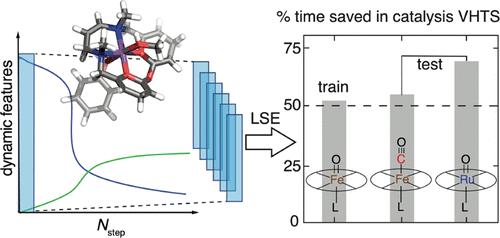当前位置:
X-MOL 学术
›
J. Chem. Theory Comput.
›
论文详情
Our official English website, www.x-mol.net, welcomes your feedback! (Note: you will need to create a separate account there.)
Machine Learning Models Predict Calculation Outcomes with the Transferability Necessary for Computational Catalysis
Journal of Chemical Theory and Computation ( IF 5.5 ) Pub Date : 2022-06-23 , DOI: 10.1021/acs.jctc.2c00331 Chenru Duan 1, 2 , Aditya Nandy 1, 2 , Husain Adamji 1 , Yuriy Roman-Leshkov 1 , Heather J Kulik 1
Journal of Chemical Theory and Computation ( IF 5.5 ) Pub Date : 2022-06-23 , DOI: 10.1021/acs.jctc.2c00331 Chenru Duan 1, 2 , Aditya Nandy 1, 2 , Husain Adamji 1 , Yuriy Roman-Leshkov 1 , Heather J Kulik 1
Affiliation

|
Virtual high-throughput screening (VHTS) and machine learning (ML) have greatly accelerated the design of single-site transition-metal catalysts. VHTS of catalysts, however, is often accompanied with a high calculation failure rate and wasted computational resources due to the difficulty of simultaneously converging all mechanistically relevant reactive intermediates to expected geometries and electronic states. We demonstrate a dynamic classifier approach, i.e., a convolutional neural network that monitors geometry optimizations on the fly, and exploit its good performance and transferability in identifying geometry optimization failures for catalyst design. We show that the dynamic classifier performs well on all reactive intermediates in the representative catalytic cycle of the radical rebound mechanism for the conversion of methane to methanol despite being trained on only one reactive intermediate. The dynamic classifier also generalizes to chemically distinct intermediates and metal centers absent from the training data without loss of accuracy or model confidence. We rationalize this superior model transferability as arising from the use of electronic structure and geometric information generated on-the-fly from density functional theory calculations and the convolutional layer in the dynamic classifier. When used in combination with uncertainty quantification, the dynamic classifier saves more than half of the computational resources that would have been wasted on unsuccessful calculations for all reactive intermediates being considered.
中文翻译:

机器学习模型通过计算催化所需的可迁移性预测计算结果
虚拟高通量筛选 (VHTS) 和机器学习 (ML) 极大地加速了单中心过渡金属催化剂的设计。然而,催化剂的 VHTS 通常伴随着高计算失败率和计算资源的浪费,这是由于难以同时将所有与机械相关的反应中间体收敛到预期的几何形状和电子状态。我们展示了一种动态分类器方法,即动态监控几何优化的卷积神经网络,并利用其在识别催化剂设计的几何优化失败方面的良好性能和可转移性。我们表明,动态分类器在甲烷转化为甲醇的自由基反弹机制的代表性催化循环中对所有反应性中间体表现良好,尽管只对一种反应性中间体进行了训练。动态分类器还可以推广到训练数据中不存在的化学上不同的中间体和金属中心,而不会损失准确性或模型置信度。我们将这种卓越的模型可迁移性合理化,这是由于使用了从密度泛函理论计算和动态分类器中的卷积层动态生成的电子结构和几何信息。当与不确定性量化结合使用时,
更新日期:2022-06-23
中文翻译:

机器学习模型通过计算催化所需的可迁移性预测计算结果
虚拟高通量筛选 (VHTS) 和机器学习 (ML) 极大地加速了单中心过渡金属催化剂的设计。然而,催化剂的 VHTS 通常伴随着高计算失败率和计算资源的浪费,这是由于难以同时将所有与机械相关的反应中间体收敛到预期的几何形状和电子状态。我们展示了一种动态分类器方法,即动态监控几何优化的卷积神经网络,并利用其在识别催化剂设计的几何优化失败方面的良好性能和可转移性。我们表明,动态分类器在甲烷转化为甲醇的自由基反弹机制的代表性催化循环中对所有反应性中间体表现良好,尽管只对一种反应性中间体进行了训练。动态分类器还可以推广到训练数据中不存在的化学上不同的中间体和金属中心,而不会损失准确性或模型置信度。我们将这种卓越的模型可迁移性合理化,这是由于使用了从密度泛函理论计算和动态分类器中的卷积层动态生成的电子结构和几何信息。当与不确定性量化结合使用时,



























 京公网安备 11010802027423号
京公网安备 11010802027423号